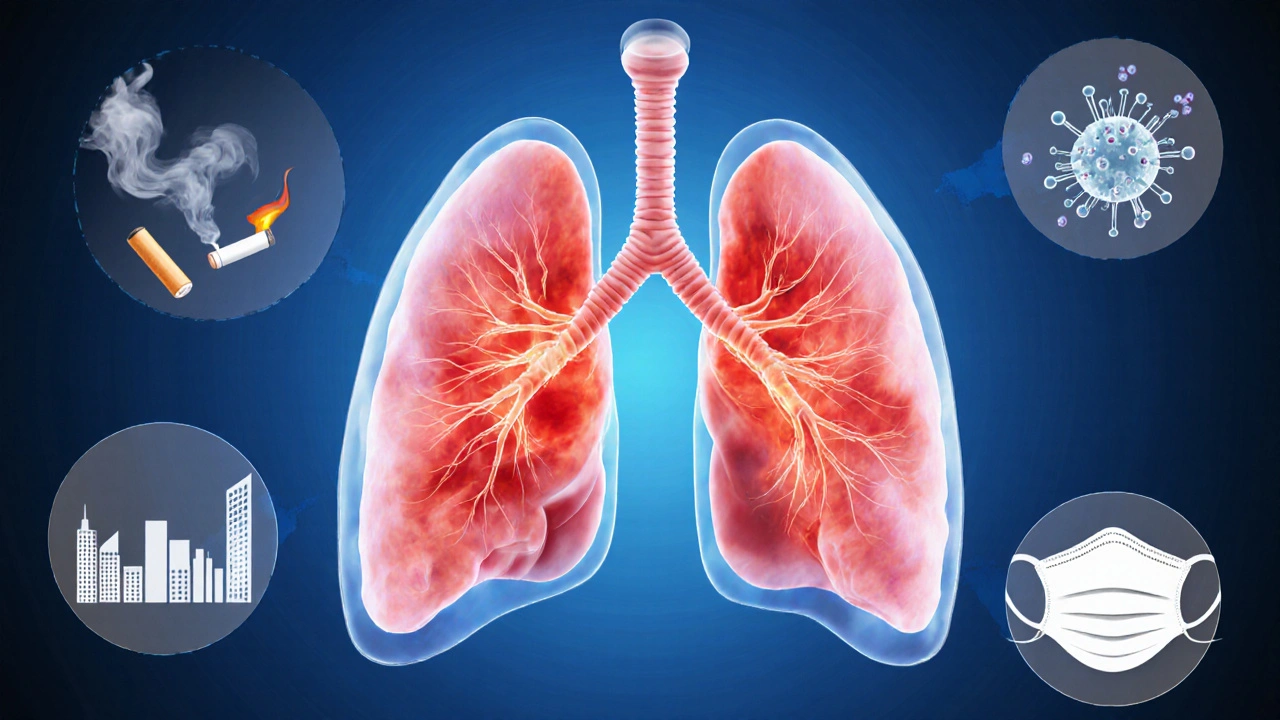Lung Inflammation Risk Factor Calculator
How This Tool Works
Answer the questions below to calculate your overall lung inflammation risk score. Each factor contributes to your risk level, which will be displayed as low, moderate, or high.
Your Risk Level
Smoking
Increases risk significantly
--Air Pollution
Depends on exposure frequency
--Allergens
Severity-based impact
--Infections
Frequency affects risk
--Chronic Disease
Baseline risk factor
--Quick Summary
- Identify the main triggers - smoking, polluted air, allergens, and infections.
- Boost lung defenses with regular exercise, a balanced diet, and proper hydration.
- Use inhaled or oral anti‑inflammatory meds only as prescribed.
- Seek medical help if symptoms persist beyond a week or worsen quickly.
- Long‑term lung health relies on quitting smoking and keeping indoor air clean.
When the lungs get inflamed, breathing feels tight, coughing spikes, and fatigue sneaks in. The good news? Most of the triggers are within your control, and the right mix of lifestyle tweaks and medical support can bring relief fast.
What Is Lung Inflammation?
Lung inflammation is a condition where the tissue lining the airways swells, producing excess mucus and narrowing the breathing passages. It can be acute - lasting days - or chronic, persisting for months or years. In everyday language, it shows up as a stubborn cough, wheezing, shortness of breath, or chest tightness.
The swelling is the body's immune response to irritants or invading microbes. While inflammation protects us, too much of it damages the delicate alveoli where oxygen exchange happens, reducing lung efficiency.

Common Causes and Risk Factors
Understanding the root helps you dodge it. Here are the top culprits:
- Smoking - the leading cause; tar particles trigger chronic airway irritation.
- Air pollution - fine particulate matter (PM2.5) from traffic and industry settles deep into the lungs.
- Allergens - pollen, pet dander, mold spores can spark inflammation in sensitive people.
- Respiratory infections - viruses (flu, COVID‑19) or bacteria (pneumonia) ignite an immune flare‑up.
- Underlying chronic diseases - asthma, chronic obstructive pulmonary disease (COPD), and bronchitis keep airways primed for inflammation.
Age, genetics, and occupational exposure (e.g., construction dust) also tip the scales. If you tick any of these boxes, you’re more likely to experience lung inflammation at some point.
Prevention Strategies That Actually Work
Prevention isn’t about a single miracle; it’s a bundle of habits that together keep your lungs clear.
1. Quit Smoking - No Exceptions
Quitting reduces inflammation risk by up to 50% within a year. Combine nicotine‑replacement therapy with counseling for the best success rate. If you’re still smoking, even cutting back to a few cigarettes a day can lower particulate exposure.
2. Clean Up Your Air
Invest in a HEPA air purifier for bedrooms, and keep windows closed on high‑pollution days (check your local AQI). Replace HVAC filters every three months. For outdoor activities, wear a mask rated N95 when air quality is poor.
3. Manage Allergens
Use dust‑mite‑proof covers on pillows, wash bedding in hot water weekly, and keep humidity under 50% to curb mold growth. If pollen is a trigger, check forecasts and limit outdoor time during peak hours.
4. Stay Active
Regular aerobic exercise - brisk walking, cycling, swimming - improves lung capacity and speeds mucus clearance. Aim for at least 150 minutes of moderate activity per week.
5. Nutrition That Supports Lung Tissue
Antioxidant‑rich foods (berries, leafy greens, nuts) combat oxidative stress caused by pollutants. Omega‑3 fatty acids from fatty fish help modulate inflammatory pathways. Stay hydrated to thin mucus.
6. Vaccinations
Flu and COVID‑19 vaccines lessen the chance of severe respiratory infections that can cascade into chronic inflammation. Pneumococcal vaccine is also advisable for adults over 65 or those with chronic lung disease.
Managing an Ongoing Flare‑Up
If you’ve already got lung inflammation, the goal is to calm the airway swelling, clear mucus, and restore breathing comfort.
Medical Options
- Inhaled corticosteroids - deliver a targeted anti‑inflammatory dose directly to the lungs.
- Oral steroids (e.g., prednisone) - reserved for severe attacks; short courses minimize side‑effects.
- Bronchodilators - relax airway muscles, making it easier to exhale.
- Mucolytics - thin mucus, helping you cough it out.
Always follow a doctor’s prescription. Over‑using steroids can suppress the immune system, so proper dosing matters.
Home Care Tips
- Use a humidifier set to 40-60% humidity; dry air irritates inflamed tissue.
- Practice deep‑breathing exercises - diaphragmatic breathing reduces chest tightness.
- Stay upright; reclining can worsen mucus pooling.
- Drink warm fluids (herbal tea, broth) to soothe the throat and keep secretions thin.
When to Call a Health Professional
Seek urgent care if you experience any of these:
- Shortness of breath at rest or worsening rapidly.
- Chest pain that doesn’t improve with rest.
- High fever (>38.5°C) lasting more than 48hours.
- Bluish tint around lips or fingertips (sign of low oxygen).

Long‑Term Lifestyle Adjustments
Beyond the immediate flare‑up, think of your lungs as a garden. Regular upkeep prevents weeds (inflammation) from taking over.
Pulmonary Rehabilitation
Programs combine supervised exercise, education, and breathing techniques. Studies show a 30% improvement in exercise tolerance for participants with chronic inflammation.
Weight Management
Excess weight compresses the diaphragm, limiting lung expansion. Even a 5% reduction in body weight can noticeably ease breathing.
Stress Reduction
Stress hormones can aggravate airway inflammation. Mindfulness, yoga, or simple daily walks help keep cortisol levels in check.
Comparison of Key Risk Factors
| Risk Factor | Typical Exposure Level | Inflammation Impact | Mitigation Strategy |
|---|---|---|---|
| Smoking | 10+ cigarettes/day | High - chronic airway irritation | Quit, nicotine‑replacement, counseling |
| Air Pollution (PM2.5) | >35µg/m³ (AQI ‘Unhealthy’) | Moderate‑High - deep‑lung particle deposit | Air purifiers, masks, limit outdoor time |
| Allergens | Seasonal spikes, indoor mold | Variable - depends on sensitivity | HEPA filters, de‑humidify, allergen avoidance |
| Respiratory Infections | Annual flu season, viral outbreaks | High - acute inflammation can become chronic | Vaccinations, hand hygiene, early treatment |
| Chronic Diseases (asthma, COPD) | Ongoing | High - baseline airway hyper‑responsiveness | Maintenance meds, regular check‑ups |
Frequently Asked Questions
Can I reverse lung inflammation without medication?
Mild inflammation often responds to lifestyle changes-quit smoking, improve indoor air, stay hydrated, and add regular aerobic exercise. For moderate to severe cases, doctors usually prescribe inhaled steroids or short courses of oral steroids to bring the swelling down quickly.
Is a cough always a sign of lung inflammation?
Not always. A cough can be due to post‑nasal drip, acid reflux, or simple irritation. However, a persistent, wet cough that lasts more than two weeks, especially with wheeze or shortness of breath, often points to airway inflammation.
How long does an acute flare‑up usually last?
Most acute episodes resolve within 5‑7days with appropriate rest, fluids, and if needed, a short steroid burst. If symptoms linger beyond ten days, it’s time to revisit your doctor for further evaluation.
Are natural remedies like ginger or honey effective?
They can soothe the throat and provide mild anti‑inflammatory benefits, but they don’t replace proven medical therapy for moderate‑to‑severe inflammation. Think of them as supportive, not curative.
What’s the link between asthma and lung inflammation?
Asthma is essentially chronic lung inflammation triggered by allergens, cold air, or exercise. In asthmatics, the airway walls are already primed to swell, so any additional irritant can quickly snowball into a full‑blown flare‑up.


Matt Tait
October 7, 2025 AT 13:54Your article totally overstates the risk; most people never get lung inflammation.
Benton Myers
October 15, 2025 AT 04:18Looks like a decent primer on what triggers lung inflammation. It’s helpful to see the risk factors broken down in a simple list.
Pat Mills
October 22, 2025 AT 18:42When it comes to pulmonary health, the stakes are nothing short of existential, and this article attempts to grapple with the myriad variables that conspire against our alveolar sanctuaries.
First, the insidious habit of smoking is portrayed not merely as a choice but as an aggressive incendiary force that ignites chronic inflammation with relentless vigor.
Second, the specter of air pollution looms like a toxic fog, seeping into nasal passages and marching unchallenged into the deepest bronchi, especially in urban jungles where AQI breaches the hundred mark with alarming regularity.
Third, allergens – pollen, dust mites, pet dander – are painted as microscopic tyrants that provoke immune overreactions, turning a harmless sneeze into a cascade of cytokine storms.
Fourth, the frequency of respiratory infections is meticulously catalogued, reminding us that each cold or flu episode is not just an inconvenience but a rehearsal for the immune system’s violent overdrive.
Fifth, chronic conditions such as asthma and COPD are described as the foundational scaffolding upon which all other risks are amplified, creating a perfect storm of vulnerability.
The calculator itself, while simplistic in its interface, serves as a stark reminder that each answer we provide is a data point whispering loudly about our personal jeopardy.
One might argue that reducing smoking to a binary choice neglects the nuanced spectrum of nicotine dependency, yet the article embraces the blunt truth that any inhaled toxin is a step toward devastation.
Similarly, the treatment of air pollution exposure as a frequency metric fails to account for the volatile composition of pollutants, but it does illuminate the importance of temporal patterns in our daily routines.
Allergen severity is rightly stratified, acknowledging that a mild hay fever differs vastly from a life‑threatening asthma flare, thereby respecting the gradient of immune responses.
The infection count, however, could benefit from distinguishing viral from bacterial origins, as their inflammatory pathways diverge dramatically.
And the chronic disease segment, while acknowledging baseline risk, omits the crucial role of medication adherence and lifestyle modifications in mitigating that risk.
Nevertheless, the overall narrative compels readers to confront uncomfortable truths: that complacency is a silent conspirator in lung degeneration.
It also nudges us toward actionable prevention strategies, from quitting smoking to seeking cleaner environments and managing underlying conditions with diligent care.
In sum, the piece is a clarion call, urging us to turn abstract statistics into personal accountability, lest we find ourselves gasping for breath under the weight of our own neglect.
Thus, the calculator is not just a tool but a mirror reflecting the inevitable consequences of our daily choices.
neethu Sreenivas
October 30, 2025 AT 09:06🧘♀️ I totally get how overwhelming all these factors can feel. Taking one step at a time-like cutting back on cigarettes or using an air purifier-can make a massive difference in calming that internal fire.
Keli Richards
November 6, 2025 AT 23:30Hey there! Thanks for breaking it down so clearly
Ravikumar Padala
November 14, 2025 AT 13:54I see the good intentions behind this guide, yet it somehow sidesteps the core issue of socioeconomic disparities that dictate who can actually afford cleaner air filters or inhalers. The tone feels a bit naive when suggesting everyone just “use a purifier” without acknowledging the cost barrier. Moreover, the risk calculator simplifies complex pathophysiology into a series of checkboxes, which might mislead people into thinking they’ve conquered the problem once they see a low score. While the advice to quit smoking is sound, the article fails to address the psychological hook of nicotine and the need for proper cessation programs. Also, the mention of “moderate infections” ignores the reality that many communities lack access to timely medical care, turning a simple cold into a serious threat. In short, the piece could benefit from a deeper dive into systemic factors rather than just personal lifestyle tweaks.
King Shayne I
November 22, 2025 AT 04:18Look, I respect the effort put into this, but the article kinda misses the mark on practical advice-most folks don’t have the luxury to just stop smoking overnight.
jennifer jackson
November 29, 2025 AT 18:42Stay positive you can make those changes step by step!
Brenda Martinez
December 7, 2025 AT 09:06This guide is nothing more than a scare tactic, dripping with melodrama while ignoring real scientific nuance and leaving readers with a false sense of dread.